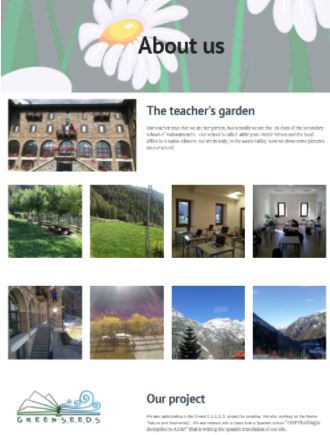Author: class II B, I.S. Abbé J.M. Trèves, secondary school (first grade), Valtournanche, Vallée d'Aoste (IT)
Partner: class VI grade, CEIP Plurilingue Espiñera Aldán (ES); class II C, I.S. Abbé J.M. Trèves, secondary school (first grade), Valtournanche, Vallée d'Aoste (IT)
Introduction

Bees website
This activity is part of the GREEN S.E.E.D.S. project, whose aim is to encourage remote interaction between students of isolated rural schools. In this project students work together on environmental themes, such as “Nature and biodiversity”. My class belongs to the Middle school (K7 level) of Valtournenche, Aosta Valley, Italy. My class worked with a Spanish class of “ CEIP Plurilingüe da Espiñeira-Aldán”. A website in four languages (Italian, French, English, Spanish) has been createdinternet: https://sites.google.com/mail.scuole.vda.it/api-abeilles-bees-abejas/home-page
Learning Objectives
- Physical features of bees
- The importance of bees in the ecosystems
- The importance of bees for our food security
- The bees and the geometry: why are cells of a honeycomb hexagonal? Which polyhedron can approximate a cell? In which way bees communicate the position, the distance and the quality of a source of nectar?
- The factors that threaten bees (chemicals, parasytes, climate changes)
- The products of the beehive. Composition of the honey
- The beekeeping (interview to a local beekeeper)
Task

A website to learn about bees
The task is to create a website about bees. It has four main goals:
- to realize the importance of bees from both the ecological and the food security points of view.
- To learn to select information and pictures, to elaborate them and to cite sources.
- To learn to build a website.
- To use French and English as languages of communication.
Here is the link: https://sites.google.com/mail.scuole.vda.it/api-abeilles-bees-abejas/home-page
Process
- Acquire knowledge about ecological relationships in different organisational levels (populations, communities, ecosystems, biosphere).
- Search for information on websites in different languages.These websites are presented by the teacher.
- Site design
- Selection of the themes to examine
- Division of tasks
- Meeting the Spanish class, presentation of the environment near Valtournenche and students’ passions and interests.
- Individual elaboration of the contents of the website (in three languages) and construction of the site (group work). Choice of images.
- Correction of errors.
- Presentation to the Spanish class.
- Collaboration with the Spanish class.
Evaluation
- Physical features of bees
- Bees in the ecosystem and for our foodsecurity
- The bees and the geometry: why are cells of a honeycomb hexagonal? Which polyhedron can approximate a cell? In which way bees communicate the position, the distance and the quality of a source of nectar?
- The factors that threaten bees (chemicals, parasytes, climate changes)
- The products of the beehive. Composition of the honey
- The beekeeping (interview to a local beekeeper)
- Writing a text
- Oral presentation of a text
- Interaction and collaboration with schoolmates
- Interaction with Spanish students
Students were assessed on:
- the text they produced
- interaction and collaboration with schoolmates
- oral presentation of the product.
- interaction with Spanish students
Conclusion
The work was particularly appreciated by students, who generally worked together in a serious way. The meetings with the Spanish class were enjoyed, but some students didn’t understand how to behave during the meetings.
The students made an effort to speak English, despite their difficulties.
Links
How to recognise bees; biodiversity
https://www.focus.it/ambiente/animali/come-riconoscere-le-api; https://conapi.it/2017/api-salvaguardia-biodiversita/; 3bee.it; terranuova.it/chiedi-all-esperto/il-ruolo-delle-api-operaie
UN: World bees day
https://www.un.org/fr/observances/bee-day; https://www.un.org/sites/un2.un.org/files/beeday_infographic_1_fr_2.png; https://www.un.org/sites/un2.un.org/files/beeday_infographic_2_fr.png







